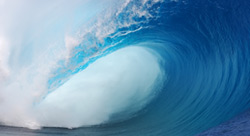Mathematica Aids Oceanographers at the NOAA in Tsunami Tracking
- Numeric—time series analysis, matrix manipulation, Fourier transforms
- Symbolic—calculus, differential equations, algebraic expansion
- Graphic—2D and 3D plots, data visualization, curve fitting, animation, export in PostScript
- Programming—list manipulation
- Notebook—research log maintenance
A tidal wave, or tsunami, holds the potential to be a highly destructive and disastrous event, especially for coastal communities. To make things worse, its often stealth-like approach leaves little opportunity for timely warnings. Once a tsunami crashes on shore its waves may rise as far as 100 feet above sea level. But generated by earthquakes beneath the ocean floor, tsunamis begin in the open ocean with waves only a few centimeters high--waves that are impossible to detect from the air or by ship. Fortunately, oceanographers at the National Oceanic and Atmospheric Administration are on the case, and they're finding Mathematica very helpful in the process.
According to computer scientist and oceanographer Ed Boss at Sigma Solutions, Mathematica's ability to handle complex symbolic calculations helped them solve problems "we simply could not have done by hand." Thus it played a vital role in helping the NOAA quantify the accuracy of the transducers in tsunami-tracking bottom pressure recorders now located on ocean floors throughout the Pacific Ocean. "Results showed that our instruments can record surface level changes of less than a millimeter," reports Boss.
"Mathematica was also used to help develop a model showing how waves grow and change as they travel toward shore. Such models may be integrated into a real-time warning system in the future. NOAA engineers are currently designing real-time bottom pressure gauges that transmit their data to the internet via satellite. "Models developed with Mathematica help us better understand the physics of wave motion. We hope to use this information to determine which kinds of earthquakes and other ground motions are most likely to produce tsunamis. Our research is targeted at improving disaster preparedness activities as well as saving lives," says Boss.
- E.F. Boss, "Tsunami Research on the Macintosh," SciTech Journal, vol. 6, no.1 (January 1996).
- E.F. Boss and F.I. Gonzalez, "Signal Amplitude Uncertainty of a Digiquartz Pressure Transducer Due to Static Calibration Error," Journal of Atmospheric and Oceanic Technology 11 (1994): 1381-1387.
- E.F. Boss and F.I. Gonzalez, "Corrections to Bottom Pressure Records for Dynamic Temperature Response," Journal of Atmospheric and Oceanic Technology 12 (1995): 915-922.
- F.I. Gonzalez, K. Satake, E.F. Boss, and H.O. Mofjeld, "Edge Wave and Non-trapped Modes of the 25 April 1992 Cape Mendocino Tsunami," Journal of Pure and Applied Geophysics 144 (1995): 409-426.
Get started with Wolfram technologies, or work with us to apply computational expertise to your projects.
Questions? Comments? Get in touch: 1-800-WOLFRAM, or email us »
























